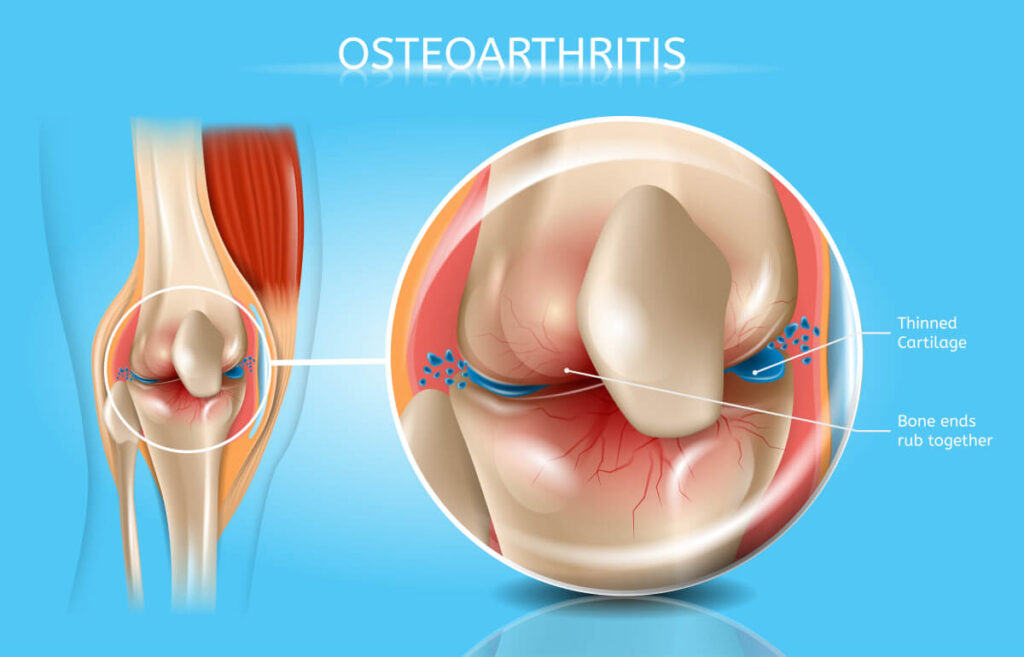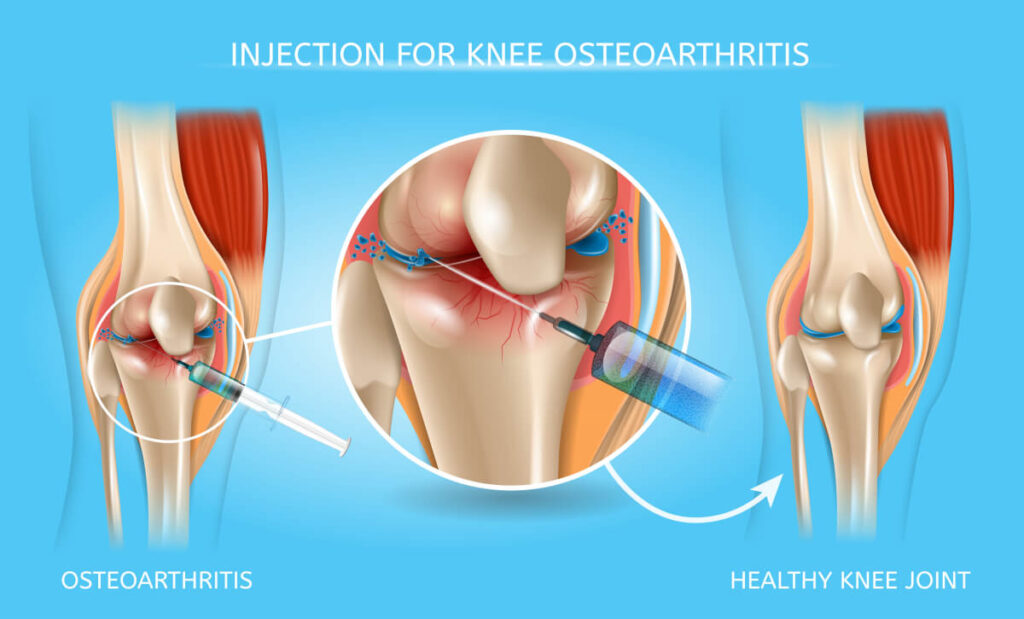Osteoarthritis of the knee is one of the most common degenerative disorders that patients over the age of 45 report – and fortunately, there are plenty of ways to treat it. Steroids and surgery are some of the more intense options, but for many patients who want to balance their quality of life with their treatment, non-invasive options are a better treatment. This is the reason why injectable treatments like stem cell therapy, PRP, hyaluronic acid, or Synvisc injections have rapidly gained popularity.
So how effective are these treatments for knee osteoarthritis? Each of these injectables can help improve your condition in various ways, but only stem cell and PRP treatment show any long-term possibilities of improving knee osteoarthritis. However, this means that almost any patient can reasonably use any of these treatments to improve their condition.
What Is Knee Osteoarthritis?

Knee osteoarthritis (or wear-and-tear arthritis) occurs when the cartilage between your joints wears out. Normally, the role of the cartilage in your joints is a shock absorber that helps you move about in relative comfort, and to absorb any other impact that can otherwise affect your joints. But if something affects the cartilage and causes it to decrease, your joints can suffer.
Causes
As a degenerative condition, age is by far the most common culprit for developing knee osteoarthritis. Your body’s wound healing and cell regrowth responses slow down over time, which also affects the overall health of the cartilage around your joints. Combined with the other functions that also get affected as you age, this causes your cartilage to get weaker and more prone to breaking down as you get older.
However, age isn’t the only cause that you need to look out for. Several other conditions, lifestyle choices, or factors can also put you at risk for developing arthritis early, like:
- Excessive weight
- Smoking or alcohol consumption
- Other forms arthritis
- Gender and genetics
- Repetitive injuries
Repetitive injuries are a cause of particular concern for most doctors since they can often signal or cause the onset of osteoarthritis of the knee without the patient even knowing about it. People who have certain jobs or do physical activities that can cause damage to the knee (like lifts, squats, or other similar activities) put plenty of pressure on the knee joint, which can cause the cartilage to wear away faster.
Symptoms
By far, the most common symptom of knee osteoarthritis is reduced mobility around the knee area. This inevitably limits your physical activity, and is also one of the easiest ways to gauge whether or not you’ve developed knee osteoarthritis as this symptom is constant and progresses over time.
Another common symptom to watch out for is pain or other sensations around the knee, especially if you move. Because the cartilage isn’t thick enough to cushion impacts or protect the nerves in your knee from making contact with one another, you may feel strange sensations in your knee, which are also a possible sign that you may be developing osteoarthritis.
These symptoms can worsen or lessen with time and certain movements, but they do tend to stick around and grow worse over time in most cases. This is why it’s important to have yourself diagnosed immediately if you suspect you’re developing osteoarthritis or are in a group that has a higher risk of developing the condition.
Why The Knee?
While osteoarthritis is a condition that isn’t limited to the knee, it’s by far the most common location that patients report symptoms with. This is because the knee is in a uniquely vulnerable place compared to the rest of the areas of your body that can develop osteoarthritis.
Aside from the range of movement that you subject your knee joints to every day, it’s also one of the areas of your body that needs to take the brunt of your weight. This isn’t just bodyweight, but any weight at all that you put on yourself throughout the day – which is another reason why some people in certain professions or sports are at risk of developing it.
Combined with the decrease in your body’s ability to repair itself as you age, the cartilages in your knee joints experience an enormous amount of strain, sometimes even without you noticing. If left unattended or if you live a lifestyle that makes it more likely to occur, then you will most likely experience osteoarthritis of the knee.
Why Non-Invasive Treatments?
Traditionally, the method of treating osteoarthritis usually involves either steroids in order to reduce the inflammation in the knee or surgery for more advanced cases, combined with some other medications. However, more and more patients are starting to gravitate towards alternative therapies and medications to reduce the strain on their bodies while still allowing themselves to treat their condition.
Part of this is because further studies on osteoarthritis have managed to isolate exactly how it works, how it progresses, and the possible ways your body can respond to treatment. We understand the condition better now, and that allows us to open the door to more methods of treatment that accommodate each patient’s needs.
But the push towards non-invasive treatments has been spurred by the development of regenerative therapies like PRP treatment and stem cell research. At the same time, non-invasive procedures like hyaluronic acid treatment and Synvisc injections have drastically improved the quality of life for people who have knee osteoarthritis. Patients now have several options to consider when getting help for their condition, with short and long-term benefits.
Injectables For Knee Osteoarthritis

Stem cell treatment, hyaluronic acid, Synvisc, and PRP therapy all fall under injectable procedures – which means that no incisions or other openings in the body need to be made. This gives them far more flexibility for patient application compared to surgery, and far fewer complications compared to stronger treatments like steroids.
Here’s a brief breakdown of how each treatment works:
Hyaluronic Acid
A natural compound found in the body, hyaluronic acid is responsible for keeping your skin hydrated and moisturized. Normally, the body produces enough hyaluronic acid or processes it from the food that we eat. But like most functions in the body, this process also slows down as you get older – so your joints are far less lubricated.
By injecting hyaluronic acid directly into your knee joints, you’re able to lubricate the connection between your bones and prevent the feedback that happens when they move against each other. It’s a relatively simple treatment that can be performed by most medical providers and can offer you pain relief for up to 6 months after consistent applications.
However, it’s important to keep in mind that hyaluronic acid injections only address the symptoms of knee osteoarthritis, not the underlying cause itself. While it’s an excellent way to get pain relief and improve the mobility of the joint, it doesn’t stop the cartilage from degenerating.
Synvisc Injections
A proprietary medication made by Sanofi, Synvisc also uses hyaluronic acid as a base ingredient for its effects. The benefits for the patient are also much the same – with lubricated joints, they’re far less likely to experience pain during their daily activities.
The primary difference between Synvisc and other hyaluronic acid injections is that its effects tend to last longer, especially for patients who have detected knee osteoarthritis early. Specific formulations like Synvisc-One only require one injection instead of the usual three for hyaluronic acid treatments, which can make it easier for older patients who may have difficulty with injectable treatments.
But like most hyaluronic acid injections, the same issue is still present with Synvisc: it doesn’t do much to slow down or stop the degenerative cause of knee osteoarthritis. The best that patients can expect from this treatment is pain relief, though the efficacy of these injections will vary from person to person.
PRP Treatment
Platelet-rich plasma (PRP) treatment is one of the newest innovations in regenerative medicine and relies on using your own body’s platelets to help with your condition. By extracting blood from your body and filtering out everything else except the platelets, providers can inject a serum of pure platelet concentrate directly into your knees for your treatment.
Because platelets are responsible for the majority of your body’s wound healing response, higher levels of platelets in your system can encourage cell regrowth and regeneration, which can repair the cartilage between your joints. This largely gets rid of the symptoms associated with knee osteoarthritis, and can even prevent the condition from progressing any further.
One thing to note about PRP treatment is that it can be difficult to give an accurate assessment of how effective the treatment will work for you since there are different standards that providers follow while going through PRP preparations. However, the process has been approved by the FDA, so it’s an exploratory alternative that you can consider if traditional methods don’t bring you pain relief.
Stem Cell Therapy
By far one of the most advanced regenerative procedures used to treat knee osteoarthritis is stem cell therapy. Using immature cells harvested from bone marrow, providers can inject them into your joints directly. These immature cells can then turn into additional cartilage, which can integrate seamlessly into your existing cartilage to further cushion your joints.
The effects of stem cell treatment can also release anti-inflammatory compounds that can decrease the pain that knee osteoarthritis patients experience, while also improving overall movement and mobility long-term. While the treatment can be difficult to access, there’s plenty of evidence that indicates it can be an excellent long-term treatment option for osteoarthritis of the knee.
However, it’s also not immune to the same issues that follow PRP therapy – specifically how effective the treatment can be for patients. There’s still much that medical professionals don’t understand about how the immature cells used in stem cell treatment work, and it’s not always a guarantee that they’ll work as intended when injected into the knee joint.
Any of these treatments can theoretically help you deal with osteoarthritis of the knee, but it’s important to have a medical expert advising you on which treatment can work best for you. Since these procedures are non-invasive, it’s even possible to use them at the same time or with traditional methods of osteoarthritis treatment.
Get High-Quality Medical Tools and Supplies From FACE Med Store Today
Regenerative or non-invasive therapies have rapidly risen in popularity as potential treatments for osteoarthritis of the knee. But patients should keep in mind that the efficacy of these treatments still needs a lot of clinical studies before they can be relied on for consistent results. If you’re thinking of going through any of the treatments prescribed on the list, always make sure to get the backing of a medical professional to ensure that there won’t be any issues with your medical treatment.
FACE Med Store specializes in providing high-quality medical tools and supplies to our customers at affordable prices, allowing them to balance quality and quantity without compromise. We cater to medical and cosmetic practices alike and have recently made our stock available for the use of the general public. Whether it’s for maintenance medication or at-home beauty treatments, you can rely on us to have the supplies that you need.
For more information about us and our stocks, visit our website today.
Learn More: Prolotherapy To Platelet-Rich Plasma Treatments for Occipital Neuralgia






